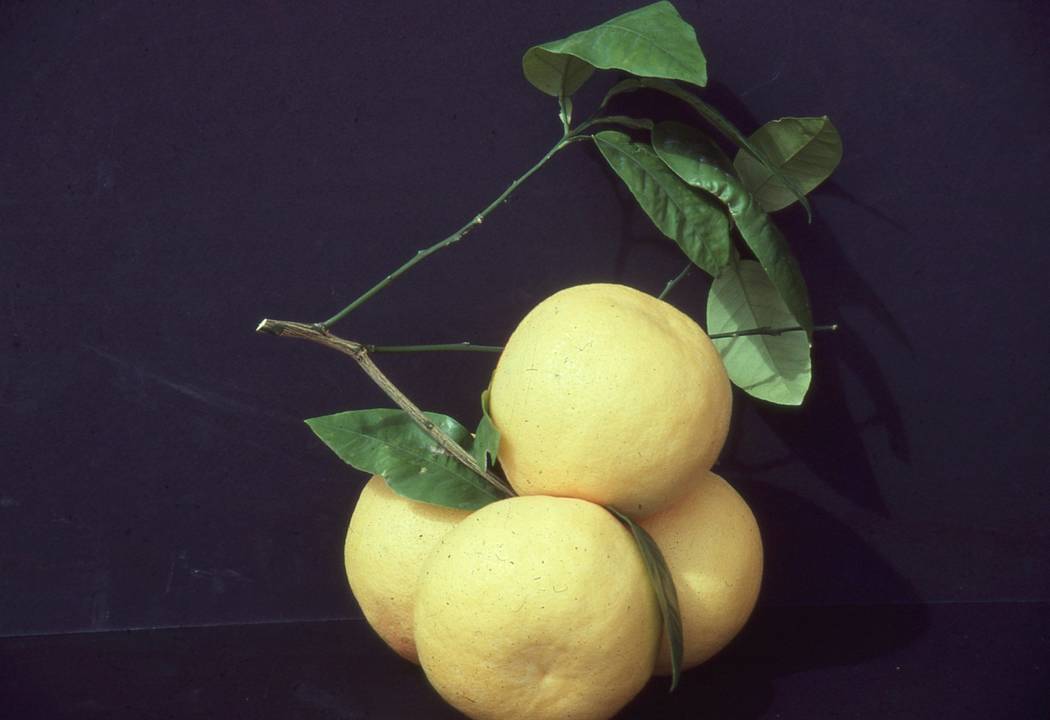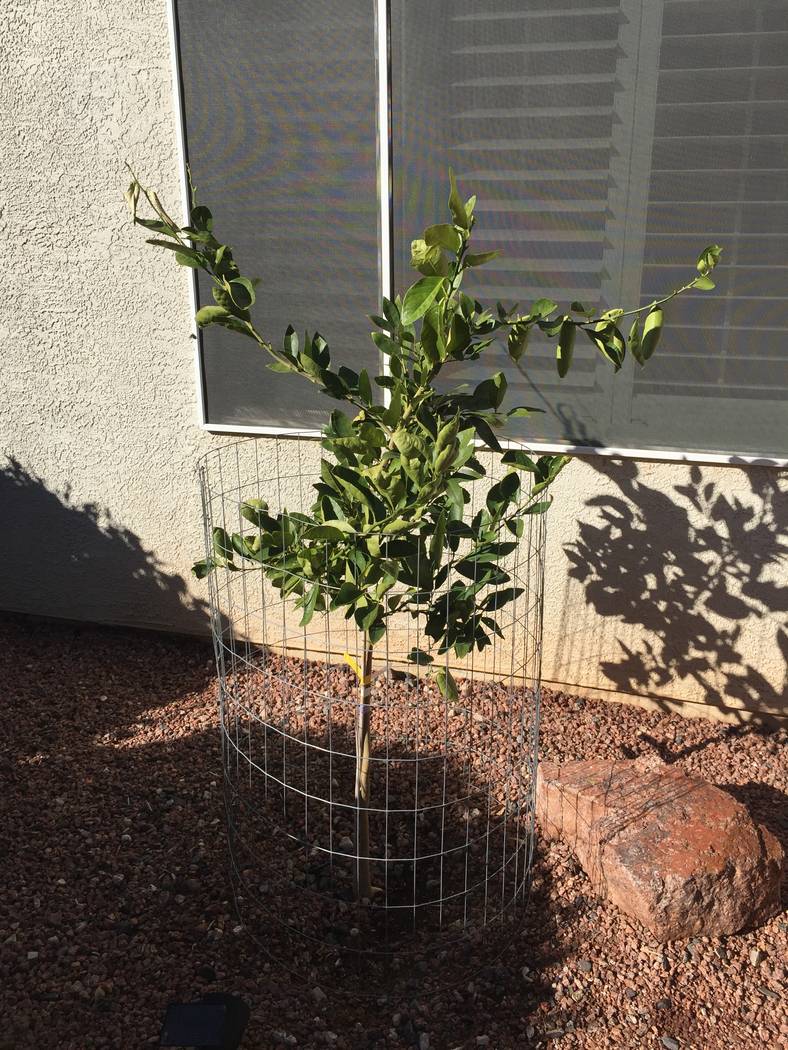Citrus plants have different tolerances to winter cold
I receive quite a few questions regarding growing citrus in the Las Vegas Valley. Some people even accuse me of not telling people to plant citrus here. That’s far from the truth.
But you should be aware there are two strikes against citrus growing well in the Mojave Desert. It’s your job, after you are aware of that, to make the right decisions and provide the care needed by them.
First, as I tell many of my students, when we choose plants that are not 100 percent compatible with our desert climate, it will cost you in personal time, energy and money to grow them here. This isn’t the same as telling people not to plant them. I just want you to be cautious and successful at the same time.
The first strike against citrus is their variable tolerance to freezing temperatures during the winter. Different citrus varieties have different tolerances to winter cold.
Plant them in the warmest part of your landscape and keep them out of the way of cold winter winds. This may require establishing some attractive man-made windbreaks to prevent wind from causing damage.
The second strike is when they flower. Oftentimes citrus trees flower in early spring, when very light freezing temperatures are possible. If freezing temperatures occur when they are producing flower buds or small fruit, tolerance to these freezing temperatures is practically nil.
This is the primary reason for the erratic production of a fruit crop by one of our most popular lemons, Meyer, even though it’s one of the most freeze-tolerant citrus plants. The tree survives, but the crop doesn’t.
All citrus trees are subtropical. Most do very well on our farm in the Philippines, where it is tropical. We don’t have the same problems with low temperatures that wreak havoc on these trees in our much colder desert climate.
Plant citrus in your landscape, have fun and enjoy their production. But do it wisely. Understand the limitations of your landscape and the limitations of these fruit trees. Find or create warm pockets where you can successfully grow citrus. Finding or creating these microclimates will produce the highest quality food possible for you to enjoy, be successful at and produce fruit more frequently.
Q: My oranges haven’t ripened on my 2-year-old tree. Some are green and others yellowish with very hard skin, and last year’s fruit wasn’t very sweet or soft. Should I cover them at night if it will be freezing?
A: The fruit of many oranges attached to the tree is damaged at temperatures of 30 degrees or a few degrees lower. The type or variety of sweet orange is highly variable to freezing temperatures. If you think winter temperatures will drop low enough for damage, then throw a sheet or blanket over the tree to protect it from cold and wind.
Go outside at night and look at the sky. Clear skies are more likely to contribute to lower temperatures than cloudy skies. If there is wind combined with freezing temperatures, fruit damage is worse.
Your oranges may not be ripe yet. Ripeness depends on the variety and when it’s supposed to be harvested. Cold weather will get them to turn orange as they ripen.
Oranges grown in tropical climates never turn orange when they are ripe. Consumers know this, and their green color is acceptable. If they are ripe enough, put them in a paper bag with a few ripe bananas for a day and they will soon turn orange.
My guess from their color is they should stay on the tree longer. If they are sweet, they may handle some temperatures down to about 28 F or so. Citrus grown commercially in the U.S. are found in Yuma, Arizona, the Rio Grande Valley in Texas, mid- to south Florida and Southern California. These places seldom freeze.
Ripe fruit handles temperatures a couple of degrees lower than unripe fruit because of their natural anti-freeze and higher sugar content. For sweeter oranges, lower temperatures by a few degrees are needed to freeze them. If you want to measure the sugar content, follow my blog and type in the word “refractometer” in the search line.
Our desert climate creates winter temperatures too low for growing and producing citrus. You might have a couple of warm winters in a row followed by low winter temperatures that may wipe out the citrus.
Will citrus grow here? Some years, depending on where they are planted and your choice in citrus. Will they produce fruit here? Sometimes, depending on when they flower and the temperatures just before and after flowering.
Talk to your neighbors and look around your neighborhood. If your neighbors were lucky at growing oranges, you might have the same luck. Be suspicious of neighborhoods that have no citrus growing in them at all. There might be a weather and climate-related reason for that, or you might be the pioneer who starts something.
Pay attention to the type or variety of orange you have. You call yours an “orange.” This orange has a name or variety besides just “orange.” These different varieties of oranges flower and are harvested at different times. Some perform better here than others.
The University of Arizona published a fact sheet that you can retrieve online called “Low Desert Citrus Varieties.” Use your favorite search engine and type in these words in quotations and look at the last two pages. This fact sheet tells you the harvest time for different varieties of citrus. Avoid varieties that are ready to harvest in the middle of December or later in the season.
Q: My crepe myrtle has not grown much since it was planted in 2012. I suspect it was not planted well in the beginning.
A: The lazy way to correct this problem is to put about a ½- to 1-inch layer of compost on the ground around the crepe myrtle 12 inches away from the trunk to about 3 feet away. Probably about 2 cubic feet of rich compost will do the trick. Occasionally water this compost, and it will sink into the soil and start improving your tree in about two years.
The faster way is to auger some holes around the trunk to about 12 inches deep and 6 to 12 inches apart. Water the area the same way. The compost will wash into these holes, and you’ll see a faster response by the plants.
It’s best to concentrate the augured holes or compost layer where irrigation water wets the soil. The compost will decompose, and the nutrients will reach the roots faster. Spreading it on the top of the soil will work, but it will take longer for the plant to get the benefits.
When you’re done doing that, cover the composted or augured area with wood chips about 3 to 4 inches deep. I would keep the wood chips about 6 inches away from the trunk.
To get free wood chips, call the master gardener helpline at 702-257-5555, but you’ll have to haul them yourself.
Looking at the picture you sent me of your crepe myrtle with all its growth at the top and no branches along the trunk for several feet, I would prune back the height. Hopefully this will force new growth lower on the trunk.
This new growth is encouraged to form new lower branches along the trunk. This new growth strengthens the trunk and causes the tree to grow greater in diameter and be healthier. You might not see much improvement for two or three years, so be patient.
Bob Morris is a horticulture expert and professor emeritus of the University of Nevada, Las Vegas. Visit his blog at xtremehorticulture.blogspot.com. Send questions to Extremehort@aol.com.



















